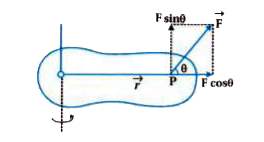Physical interpretation of the definition of torque :
 Solution in Gujrati
Solution in Gujrati
As shown in the figure a force →F is acting on a particle P of rigid body.
Force →F is taken in the plane perpendicular to the axis of rotation.
The axis is perpendicular to the plane of the figure and passing through point O. The position vector of P w.r.t. the centre of its circular path is →r. The angle between →Fand→r is θ.
To examine the effectiveness of the force in produing rotational motion, →F can be resolved into two mutually perpendicular components.
(1) Component of →F parallel to →r is Fcosθ which does not produce rotational motion.
(2) Component of →F perpendicular to →r is Fsinθ. Which can produce the rotational motion. If F and/or θ large, →F will be more effective. Moreover if the position vector →r of the point of application of the force →F is large, the effectiveness of the force in producing rotational motion is more.
Thus the quantity responsible for producing rotational motion is not only →F but rFsinθ. If can be written in vector form as under.
→τ=→r×→F
Torque is the measure of effectiveness of force in producing rotational motion.
Topper's Solved these Questions
- SYSTEMS OF PARTICLES AND ROTATIONAL MOTIONBOOK - KUMAR PRAKASHANCHAPTER - SYSTEMS OF PARTICLES AND ROTATIONAL MOTIONEXERCISE - SECTION-A (TRY YOURSELF (VSQs))
94 Videos
- SYSTEMS OF PARTICLES AND ROTATIONAL MOTIONBOOK - KUMAR PRAKASHANCHAPTER - SYSTEMS OF PARTICLES AND ROTATIONAL MOTIONEXERCISE - SECTION-B NUMERICALS
29 Videos
- SYSTEMS OF PARTICLES AND ROTATIONAL MOTIONBOOK - KUMAR PRAKASHANCHAPTER - SYSTEMS OF PARTICLES AND ROTATIONAL MOTIONEXERCISE - SECTION-F (SECTION-D) QUESTIONS PAPER
1 Videos
- QUESTIONS ASKED IN JEE - 2020 BOOK - KUMAR PRAKASHANCHAPTER - QUESTIONS ASKED IN JEE - 2020 EXERCISE - Question
16 Videos
- THERMAL PROPERTIES OF MATTERBOOK - KUMAR PRAKASHANCHAPTER - THERMAL PROPERTIES OF MATTEREXERCISE - Question Paper (Section - D) (Answer following in brief :) Each carry 4 marks
1 Videos
Similar Questions
What is a rigid body ? Explain the differences between rigid body and solid body.
View SolutionFind the centre of mass of three particles at the vertices of an equilateral triangle. The masses of the particles are 100g, 150g, and 200g respectively. Each side of the equilateral triangle is 0.5m long.
View SolutionA rope of negligible mass is wound round a hollow cylinder of mass 3 kg and radius 40 cm. What is the angular acceleration of the cylinder if the rope is pulled with a force of 30 N? What is the linear acceleration of the rope? Assume that there is no slipping.
View SolutionA non-isotropic solid metal cube has coefficient of linear expansion as 5×10−5/∘C along the x-axis and 5×10−6/∘C along y-axis and z-axis. If the coefficient of volumetric expansion of the solid is n×10−6/∘C then the value of n is....
View SolutionIn an experiment on the specific heat of a metal, a 0.20 kg block of the metal at 150∘C is dropped in a copper calorimeter (of water equivalent 0.025 kg) containing 150 cm3 of water at 27∘C. The final temperature is 40∘C. Compute the specific heat of the metal. If heat losses to the surroundings are not negligible, is your answer greater or smaller than the actual value for specific heat of the metal ?
View Solutionsymmetric difference of two sets representation and physical interpretation
View SolutionPhysical interpretation
View SolutionComposition of function: definition physical interpretation
View SolutionINTEGRATION AS THE LIMIT OF SUM - Concept and physical interpretation
View SolutionDefinition geometric interpretation: Multiplication Of A Vector By A Scalar
View SolutionDefinition and physical interpretation: Linear Combination
View SolutionDefinition; remarks and geometrical interpretation of Scalar Product
View SolutionProve that ˆi×(→a×→i)+ˆj×(→a×→j)+ˆk×(→a×→k)=2→a
View Solutionजड़त्व-आघूर्ण की परिभाषा बल-आघूर्ण एवं कोणीय त्वरण के पदों में लिखिए।
View Solutionभौतिकी के सूक्ष्म कार्यक्षेत्र से संबंधित परिघटनाओं की व्याख्या किस सिद्धांत द्वारा होती है?
View Solution
